Just Add Monsters Q&A
We talk to the developer of Kung Fu Chaos about the upcoming game.
Kung Fu Chaos is the upcoming game from UK developer Just Add Monsters. The game is an arcade-style brawler for up to four players, and it has a kung fu movie theme. We had a chance to talk to Tameem Antoniades, designer for the game and cofounder of Just Add Monsters, to find out more about it.
GameSpot: How long has the game been in development?
Tameem Antoniades: Although we'd done a significant amount of design work previously, we actually started work on the game in January 2001 for another system. We moved to Xbox in July of that year when we signed up with Microsoft, so a little over two years.
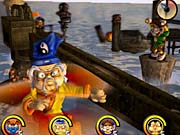
GS: How big is the team?
TA: The team size was up to 22 people in peak production but has ramped up steadily from scratch.
GS: What have they worked on before?
TA: We have lots of experienced people and lots of talented new people. A few of us worked for Sony Cambridge on some of their key million-selling titles, and we want to continue that tradition on the Xbox with JAM's first title, Kung Fu Chaos.
GS: Where did the inspiration for the game and its theme come from?
TA: Gameplay-wise, it was influenced by International Karate on the Amiga, Super Bomberman on the SNES, Mario Party on N64, and Virtua Fighter. We wanted to relive those kind of drunken, manic, multiplayer sessions that we used to have. We don't get much time to play games anymore, and when we do, it's usually in some kind of social context. We felt that there weren't enough games that satisfied our needs in this area.
You may be surprised to hear that we actually completed the design of the game before Powerstone 2 and SSBM had even been announced. Certainly, those two games did up the competitive ante for us, but Kung Fu Chaos is a very different beast--it supports a very different and more diverse gameplay experience and has its own style and personality. I believe that Kung Fu Chaos could be considered an evolution in the genre that builds and improves on anything that has come before.
The theme was easy. We like kung fu movies, so we decided to base it all around cheesy kung fu movies. Sure there are lots of fighting games around, but there is nothing that tries to capture the Hong Kong way of doing things.
GS: Could you tell us about the changes the games has gone through since we last saw it earlier last year?
TA: As you know, we were due to launch for Christmas. Had we released the game then it would have been a very good game, but we took the opportunity to ensure Kung Fu Chaos is a great game.
We knew what areas needed to be improved, as we had a lot of good quality feedback from play tests and Microsoft Game Studios. For example, many people felt the timing on combos was off. The combos felt too slow for hard-core gamers and too fast for casual gamers. Similarly, the difficulty setting was too hard for some and too easy for others. Other opportunities for improvement included cameras, controls, combat, AI, player learning, graphics, sound, single-player experience, etc. And we feel strongly that we have delivered on those aspects.
So, for example, we added leeway in the combo system so that the response of the character adapts to the timing of the player's button input. For difficulty balancing, the game adapts to your skill level and rewards you with extra features the better you play. One by one we tackled the issues and found solutions that made everyone happy without having to compromise gameplay. I guess the biggest area was the single-player game. Kung Fu Chaos has a substantial single-player mode that in itself has greater longevity than many dedicated single-player games.
We then reached a point where everyone in the play tests, both skilled and unskilled, were raving about the game and saying how the difficulty, controls, combat, and just about everything else felt great!
GS: What games did the team look to for inspiration in refining the gameplay?
TA: We wanted to create a good multiplayer combat engine that had depth but was completely accessible, so we really took our cue from established one-on-one fighting games to establish a solid core system. We did look at some competitive games but weren't overly impressed by their implementation--some lacked depth, while others encouraged players to avoid rather than engage in combat. I think our taunting system is a more effective power-up system and one which fits well with the theme of the game and adds a new layer of strategic combat. Much of the combat outside of the core systems was totally based on kung fu movies: wire jumps, multi-opponent blocking, use of objects, traps, etc.
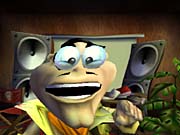
The multiplayer and single-player minigame-style arenas are based on the design philosophy of the games of yore in that they are deceptively simple but offer some furious fun. This includes both old-school video games like Pooyan as well as playground games like jumping over the spinning skipping rope. You could very quickly implement them, play them, and make changes until they were fun. Often these days, teams end up creating an engine for two-plus years, get the levels functioning just before the ship date, and release it to the public without actually getting any time to refine, refine, and refine again. We never really had that problem.
GS: What were the key gameplay elements you wanted the game to have? How challenging were they to implement?
TA: First of all, the combat was really hard. We knew this would be the case, so we have this system in the game where every move has over 100 tweakable parameters to control its speed, damage windows, interrupt windows, button timings, and so on. Each character has about 40 combos, and there are nine playable characters in the game. Each move in each combo for every character had to be tested against all other moves to make sure that the mechanics of attacking, blocking, block-breaking, counters, counter-breakers, trips, taunts, etc. all worked perfectly across the board. And that's on top of making it fun, accessible, and seamlessly integrated with the environment interaction.
The replays were a real nightmare, but the results are terrifically fun and humorous to watch. Because we are streaming up to eight audio tracks at the same time off the poor HD, we have to save replays to memory while you fight. So to save on space, only pad movements and buttons are stored. This means that all the AI in the game uses virtual controller inputs to control the characters. Because the replays run at 30fps to closer simulate film, there was a real danger that the timings of the replays could get thrown off, and the characters would end up doing stuff in the replays that never actually happened in the main game. We eventually nailed all the little problems, but it took a real mammoth effort to do this.
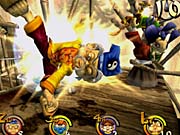
Most games of this kind live and die by their camera. We took unprecedented steps in dealing with this issue, often redesigning whole levels over and over to make sure the camera view and pacing was working well. This was the hardest, most time-consuming, and downright frustrating part of the development process. Whole levels would have to be redesigned, reanimated, rebuilt, and retextured time and time again until we were absolutely happy with the flow of the gameplay and camera. We now have a camera that is probably the best in the genre of multiplayer single-screen games, and it should be because so much work was put into it. Hopefully you won't even think about it while playing Kung Fu Chaos.
GS: What have been the biggest challenges in developing the game?
TA: The biggest challenge was at the beginning. Three people trying to find several million dollars to fund a game about bad kung fu movies is not an easy task. Eventually the forward-thinking vision of the Argonaut and Microsoft Game Studios guys gave us the opportunity we craved. So far, I believe that we have achieved everything we set out to do. The next challenge is now out of our hands: We want people playing and enjoying Kung Fu Chaos and spreading some word of mouth so that it becomes a hit.
GS: How is the graphics engine using the Xbox hardware? What was your biggest challenge in working on the game's graphics?
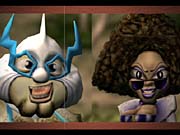
TA: We're using the Xbox to create some cool aged-film, retro-looking filters over the game to give it that '70s vibe. In particular, check out the replays where you get a full range of '70s-style VT effects. I think it's quite cool that it takes the advanced pixel shaders of the world's most powerful console to make a game that looks like an old movie.
The big graphical goal for us was to maintain 60fps gameplay. Sometimes you see games that have all the bells and whistles in screenshots, but when you play them, they are ruined by choppy frame rates. We wanted gameplay to run at 60fps at all times, no exceptions, no compromises. We reached a point where adding just one wafer-thin particle effect would cause the frame rate to spike. This was unacceptable, yet some people wanted more detail and more effects everywhere. How to win? Well, we switched to a mode on the Xbox called field-rendering that allows you to claw back a large chunk of GPU time. This allowed us to add extra detail in textures, extra visual effects, bigger combat effects, in-game sepia, depth-of-field effects, and real-time motion blur. The only caveat is that the game must run at 60fps for this mode to work--it cannot skip even a single frame without causing the whole screen to jump terribly. It took months to remove every single tiny frame rate spike, but it really paid off. I think the visual quality of Kung Fu Chaos will surprise people when they see it in action.
GS: Could you take us through the game modes and give us an idea of what they're going to offer? TA: Sure. Ninja challenge is the primary single-player game. Choose an actor and fight your way through a clan of mysterious evil ninjas on a series of spectacular movie sets. Shao Ting, the director, will rate your performance, and you must achieve at least a three-star rating to unlock new scenes. Score four or five stars in various scenes to unlock new game modes, characters, gameplay options, character bios, and special cutscenes.
Battle game is the primary multiplayer game. Up to four human players or computer-controlled players can battle it out in teams or in a free-for-all using a wide variety of options.
Championship is an unlockable multiplayer game ideal for a long session of play. Play individually or in teams. Each round is scored, and the highest score at the end will answer the age-old question of who is the ultimate kung fu master.
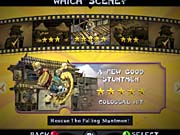
Miniseries is a single-player unlockable game containing three unique and addictive challenges for every character.
Freestyle is a multiplayer arena, which is perfect for trying out moves and perfecting your kung fu technique.
Rehearsal is a series of focused lessons that will guide you through the basic moves as well as advanced combat.
In addition to the game modes, Kung Fu Chaos offers five different ways to play multiplayer game modes.
Lives--the player with the most lives remaining at the end wins. Kills--score one point for every player you kill. Mojo--mojo is a golden light that swirls around the mojo holder. Kill the player with the mojo to steal it away. The player who has mojo for the longest time wins. Style--score big points for pulling off spectacular moves. Wooden man--destroy the most wooden men to win. If you kill a player, they will receive a three-second penalty before reappearing, so you have time to get more wooden men. Kill them with a super attack and they'll be out for six.
There are a few other options, such as game speed and film effects, that can be layered on top of the above as well as some really fat, juicy grublike Easter egg options.
GS: What's the story behind the game?
TA: Director Shao Ting has just returned to Hong Kong after his horrific failure in Hollywood. He's furious with Hollywood and wants to stick up two fingers at them by making the greatest kung fu movie ever. So he gathers together his finest actors to create his amazing epic. Unfortunately for them, he's big on ideas but not on safety. So in addition to contending with the evil ninja clan, the actors face the challenge of collapsing sets.
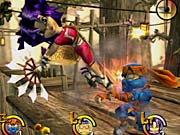
The actual story of the film you are taking part in is pretty crazy. You know how when you are asked to write a story when you are about 8 years old you kind of go: "and then the monsters came and then I escaped in a jet...and then this...and then that"? That's the kind of brain stream that Shao Ting has for the movie. So you start off making a traditional kung fu movie, but as you continue to play, it degrades and transforms into this chaotic multigenre beast of a movie involving anything from flying ninja forests to dinosaurs to martians. It's just a big fat excuse to create diverse and entertaining levels to play in.
GS: Could you give us a rundown of the game's characters?
TA: OK, here are some brief descriptions and, in the kung fu movie spirit, mistranslated quotes from the actors themselves:
Master Sho-Yu--Taoist priest and old guy skilled in the art of magic: "I possess the strength of the ox and the mind of intellectual ox!"
Ninja Fu Hiya--Is he for real or is he a ninja-wannabe?: "I speak for us when I say nothing! Nothing at all!"
Monkey the Monkey God--Based on the ancient Chinese legend, he has been banished from heaven for getting drunk and urinating on a popular deity: "Just like my poo, you will be flung!"
Chop and Styx--Chop is a deadpan lone samurai assassin, and Styx is his son, assassin-in-training: "I am the sender of fear, bringer of fate, and carrier of baby!"
Xui Tan Sour--Girl with deadly fans always out for revenge for something or other: "Every step forward is not two steps backward, but instead a bleeding head!"
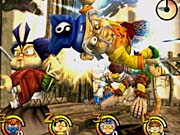
Lucy Cannon--So tough, even Shaft wouldn't come near her: "Daaaaamn straight!"
Candi Roll--Ex-porn star roller-skating girl who learned to fight on the casting couch: "Their adorable little chins are just so hittable!"
Captain Won Ton--Seventies-style wresting champion from the Mexican lucha-libre world with a superhero complex: "Wrestler by day, justice avenger by rest of the day. Able to leap puddles in less than three steps, faster than indigestion, stronger than..."
Finally we have Shao Ting, the director--A very manic and passionate man with a disturbed past, slightly screwy, slightly pervy: "You fired! And whoever hired you unless it was me!"
Each character is totally unique both in character and in animations, and each has their own devastating super attacks. They also each have a quest that you can complete to reveal more about their character and background. They are based on kung fu movie figureheads and '70s icons.
GS: Could you give us an idea of how the interactive environments are going to work?
TA: There is a range of different types of environments from the single- and multiplayer minigames to the large main features. The minigames are focused around very simple interactions between the player and the environment. We wanted to focus on pure fun in the simplest possible way yet while retaining depth. People who have played our minigames are always surprised at how fun and strategic they are, which is perfect for multiplayer sessions.
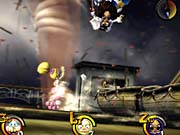
The "main features" are by contrast played on massive moving action set pieces, which are much more fighting based. Players must keep up with the action and try and knock down opponents long enough to throw them into traps or offscreen. Once you learn how the main features behave, you can time moves and combos to take advantage of this. For example in the Enter the Dino level, there's a point where the T-rex bites an outhouse off the raft revealing a toilet. If you knock someone towards the toilet, the dino will swallow them whole.
Loosely speaking, the main levels seesaw between fight areas, where players can just focus on beating up each other, and action sequences, where the environment becomes so dangerous that pausing to fight can cost you your life. Within all main features, there is no lack of objects to smash on each other or trapdoors to activate. In fact, the great thing about the levels is the way the scenario and traps conspire to dramatically change the way you play from one moment to the next. In some ways each main feature is like a bunch of diverse arenas strung together to make a spectacular whole.

GS: What are you proudest of in the game so far?
TA: The "fun factor." Games are getting so complex and elaborate, but many seem to be doing so at the expense of their primary objective: to be fun. We have never lost sight of the fact that Kung Fu Chaos is and always was about letting people have fun.
GS: What are you currently working on in the game?
TA: Well, the game's done! It's currently going through its final test passes, so lots of the guys are taking well-deserved holidays, and we're kicking off new projects.
Got a news tip or want to contact us directly? Email news@gamespot.com
Join the conversation